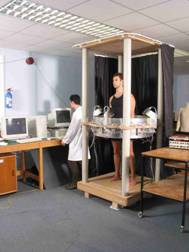Project Name:
A high integrity channel for electromagnetic imaging inbiomedicalapplications.
Background:
The world faces a double burden of disease as the nutritional deficiencies affecting the poorest and most vulnerable in society are compounded by the rapidly increasing problems of ill-health associated with dietary excess and nutritional imbalances with the more affluent. The measurement of human body composition is fundamental to this field of research and a variety of techniques are used; reference methods give good estimates, but are unsuitable or too expensive for routine us; field methods are quick and convenient, but have much poorer accuracy (Ellis 2000). This project aims to bridge this gap and move towards a rapid, safe, accurate, easy to use, and inexpensive system that uses low level electromagnetic (EM) fields to image inside the human body.
System Overview:
The new system exploits two complementary technologies; 3D scanning to measure the external body shape, and electromagnetic (eddy current) scanning to determine internal composition based on differences in electrical conductivity of the major body compartments (Gabriel). Looking at these technologies in more detail:
i. The use of full-body 3D optical scanners is increasing in the clothing industry. These systems usually contain an array of cameras and structured light sources and have adequate accuracy for cloth sizing and fashion applications. However, present systems are unable to determine body volume to the accuracy required for composition studies (Wells) and the further mechatronic development is required.
ii. Eddy current scanning is very well established in industry for non-destructive testing (NDT) of metallic components, however the use of this approach for biomedical applications is in its infancy and the relatively low conductivity of the object material presents a significant challenge. A number of groups are researching eddy current methods for tomographic imaging, and the first very coarse images have recently been published. The limited signal to noise performance of transmitter-receiver channels is a serious limitation.
iii. The integration of 3D and eddy current techniques offers a powerful combination. The shape information is vital a priori knowledge in the solution of the inverse eddy current problem, which is also an active theme of research.
Experimental rig shown in top right corner provides a background to this group project (Peyton).
Aims:
The project directly addresses the limitations of the transmitter-receiver channel described above by using the latest analogue and digital techniques to engineer a high fidelity data acquisition system specifically designed for low conductivity eddy current applications.
The main work packages include (with desired skills in brackets):
• Optimising the transmitter and receiver elements
(Electromagnetics and fields)
• Low noise front-end analogue electronics (Analogue)
• Analogue-to-digital conversion using the latest high-speed
ADC’s (Data acquisition)
• Signal demodulation using either FPGA or DSP schemes.
(Digital / micro-processor)
• Serial interface to a PC, e.g. USB or Ethernet (digital)
• User software for display and drivers for system integration.
(Software)
Industrial:
The project will be supported by NIS Ltd a medium sized company (200 employees), which specialised in front end design and feasibility studies, detailed design and development, manufacture, assemble and testing, of both specific items of equipment as well as fully integrated turnkey plants. Their division Petrie Ltd has interests in advanced EM systems and the company are well placed to advise on the integration aspects.
The company will cover the consumable cost of the project and oversee progress.
References:
Ellis KJ “Human body composition: In vivo methods”, Physiol. Rev. Vol. 80, pp.649-680, 2000
Gabriel C, Gabriel S and Corthout E, “The dielelectric properties of biological tissues: I. literature survey”, Phys. Med. Biol. Vol. 41, pp. 2231–2249, 1996
Igney CH, Pinter R, Mühlsteff J, Brauers, and Such O, “Planar magnetic induction impedance measurement system with normal sensor alignment for vital signs detection”, in 6th Conference on Biomedical Applications of Electrical Impedance Tomography
Peyton AJ, Tapp HS, Ktistis C, Mackin RO, Wan-Daud WA, Goss D, and Crescenzo E, “The development of a novel body scanner to measure human composition”, in Proc XII Int. Conference on Electrical Bio-Impedance, Gdańsk, Poland, 20-24 June 2004
Wells J C K, Douros I, Fuller N J, Elia M and Dekker L “Assessment of body volume using 3-dimensional photonic scanning”, Ann NY Acad Sci Vol. 904, pp. 247-54, 2000
